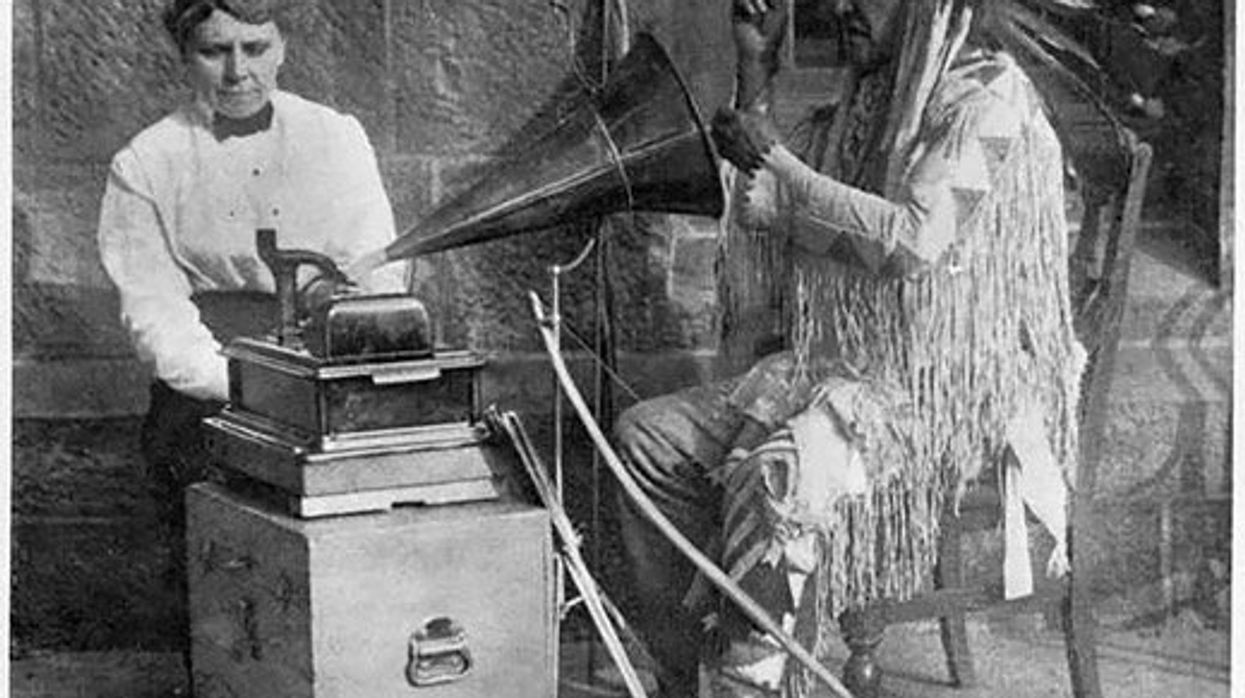The picture associated with this month’s Dojo is one of my all-time favorites. Taken in 1916, it marks the collision of two diverging cultural epochs. Mountain Chief, the head of the Piegan Blackfeet Tribe, sings into a phonograph powered solely by spring-loaded tension outside the Smithsonian. Across from him sits whom I consider the patron saint of American ethnomusicologists—the great Frances Densmore.
You can feel the scope and weight of the ancient culture of the indigenous American West, and the presence of the then-ongoing women’s suffrage movement, which was three years from succeeding at getting the 19th Amendment passed by Congress. That would later happen on June 4, 1919—the initiative towards granting all women of this country the right to vote. (All American citizens, including Black women, were not granted suffrage until 1965.)
Densmore traversed the entire breadth of the country, hauling her gramophone wax cylinder recorders into remote tribal lands, capturing songs by the Seminole in southern Florida, the Yuma in California, the Chippewa in Wisconsin, Quinailet songs in Northern Washington, and, of course, Mountain Chief outside the Smithsonian in Washington, D.C. Author of more than 20 books and 200 articles, she carefully preserved the rich cultural diversity of Native Americans with over 2,500 field recordings.
Why am I writing about this? Firstly, to pay homage! Secondly, because it serves as a great reminder to seek and cultivate sound outside the studio as well. We live in a time of great technological power and convenience. Every week a new sample pack, plugin, pedal, or software instrument hits the market. For all the joy that these offerings bring, they deprive us of the joy of creating our own instruments from scratch.
This month, I’m advocating for you to make some field recordings of your own—nature, urban, indoor, outdoor, specific locations, animals, or anything that piques your interest! Bring the material back to the studio and make music with it! I’ll show you how to make your own sample libraries to use in your music. Tighten up your belts, a multipart Dojo is now open.
What do you need to get started? Quite simply, you just need any device that is capable of recording. This can range from your cell phone to a dedicated field recorder. The real question is: Do you want to use mics housed in handheld units or have more robust mic pres with the ability to power larger live/studio microphones using XLR connectors found with the larger units? Let’s look at three scenarios.
The Cellular Approach
The absolute easiest way to get started is with your cell phone. Take advantage of a voice-memo recording app, or use an app that records multitrack audio like GarageBand on iOS. Phone recordings tend to sound very compressed and slightly lo-fi—which might be exactly what you want. However, the method can also introduce unwanted noise artifacts like low-end rumble (from handling the phone) and phasing (moving the mic while recording). I recommend using a tripod to hold your phone still while recording. You might also want to consider using an external mic and some software to edit your sample recordings on the phone. I like using a Koala Sampler ($4.99) on iOS devices.
Upgrade Me
The next step up is to use a portable recorder. These have much better mic pres, and offer true stereo recording with pivoting mic heads. This can give you the added benefit of controlling the width of your stereo image when recording or helping isolate two sound sources that are apart from each other. You sacrifice the ability to easily edit your recordings. You simply import them into your computer and edit the recording(s) from there.
Pro-Level Quality
I would recommend this scenario if you want to record multiple sources at once. These devices also have SMPTE time code, 60+ dB of gain, phantom power (+48 volts), advanced routing, and a 32-bit/192 kHz sampling rate, so you’ll never have a distorted recording even when the meter gets unexpectedly pegged into the red from a loud sound source. I recommend the Zoom F8n Pro ($1099). Now you can use your microphones!
Best Practices
Try to safely record as close to the sound source as you can to minimize ambient noise and really scrub through your recordings to find little snippets and sound “nuggets” that can make great material for creating your own instrument and sample library—which we’ll explore next month! Namaste.










![Rig Rundown: AFI [2025]](https://www.premierguitar.com/media-library/youtube.jpg?id=62064741&width=1245&height=700&quality=70&coordinates=0%2C0%2C0%2C0)


